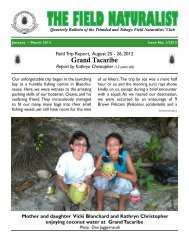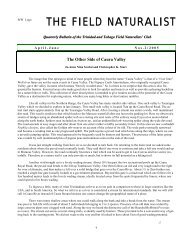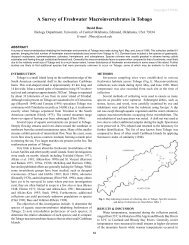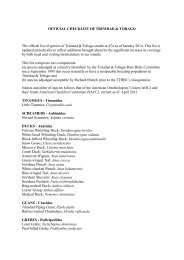Vol 2 - The Trinidad and Tobago Field Naturalists' Club
Vol 2 - The Trinidad and Tobago Field Naturalists' Club
Vol 2 - The Trinidad and Tobago Field Naturalists' Club
You also want an ePaper? Increase the reach of your titles
YUMPU automatically turns print PDFs into web optimized ePapers that Google loves.
THE FIELD NATURALIST No. 2/2006of the peak. <strong>The</strong>y probably learned not to be in such a hurry as to get too far from the designatedtrail guide.Near to the top of the mountain we were able to see the giant bromeliads (Glomeropitcairniaerectiflora) which provide the microhabitat of the golden tree frog (Phyllodytes auratus). <strong>The</strong>weather atop the peak was clear <strong>and</strong> hot, <strong>and</strong> it was noted that we were lucky to have had suchgood weather. Nicholas See Wai identified a large spectacled owl (Pulsatrix perspicillata) that thegroup startled, but rewarded them for this by allowing them to see how impressive <strong>and</strong> effective itslarge wingspan was.We reached the top of the peak at about 12 noon, <strong>and</strong> rested for about 45 minutes before westarted the descent. <strong>The</strong> ascent to the top was accomplished quite competently by Kaitlin <strong>and</strong>Joachim Snow of Scotl<strong>and</strong>, aged five <strong>and</strong> seven respectively. Before we left, Selwyn Gomes <strong>and</strong>company planted an electronic thermometer on the behalf of Victor Quesnel on the peak so as toget readings on what the temperatures on El Tuchuche’s (At 972 m above sea level, it is one of thefew places in <strong>Trinidad</strong> left where one can experience the full effects of cloud forests.) Preliminaryreadings so far have indicated that the temperature drops to about 19C, <strong>and</strong> I’m sure we all lookforward to reading about more details of Dr. Quesnel’s findings in either future issues of theQuarterly bulletin or the club’s journal.Botany Group trip – Fishing PondMarch 18 th 2006Nicholla JohnsonA group of thirty one members, family <strong>and</strong> friends of the <strong>Trinidad</strong> <strong>and</strong> <strong>Tobago</strong> <strong>Field</strong>Naturalists’ <strong>Club</strong> visited the forest in the Fishing Pond area located on the east coast of <strong>Trinidad</strong>just southeast of Sangre Gr<strong>and</strong>e. <strong>The</strong> group was accompanied by Mr. Takoorie Boodoo a ForestryDivision Honorary Game Warden from the area who assists with the patrolling of the Fishing Pondbeach during the turtle nesting season. We started off on the road that runs alongside the river inthe area formerly cleared <strong>and</strong> developed for rice cultivation, which was being used for short cropcultivation at the time of our visit. <strong>The</strong> ab<strong>and</strong>oned, wetter parts were seen to be overgrown with thenative marsh vegetation such as the yellow flowering Canna glauca, the Maranthaceae Thalia sp.,<strong>and</strong> the aroid Montrichardia arborescens a familiar sight in the Nariva Swamp, <strong>and</strong> the MarianneRiver mouth. Another dominant marsh species observed was the lovely green expanse of the sedgeEleocharis mutata that is common on the “highway side” of the Caroni Swamp. Also seen werethe roadside weeds Lantana trifolia with its purple flowers, <strong>and</strong> the common black sage (Cordiacurassavica).Along the riverside was the thorny purple flowering legume Machaerium lunatum withgreen, flat, spiral pods as well as a noticeably solitary Avicennia germinans with pneumatophoresgrowing from great heights of the tree. This was the site of a bird rescue by John Lum Young whorescued a tropical mockingbird hatchling (Mimus gilvus) that had fallen from its nest <strong>and</strong> returnedit to safety. Also at this location was a dredging barge that was stuck in the river where the waterlevel was notably too low for it to float. We also observed on the edge of the nearby forest theround-stemmed species of Cyperus articulatus.<strong>The</strong> group proceeded across an old sluice gate <strong>and</strong> feasted on guavas from a guava tree(Psidium guajava) that was growing on the forest margins. <strong>The</strong> thorny palm Bactris major12








